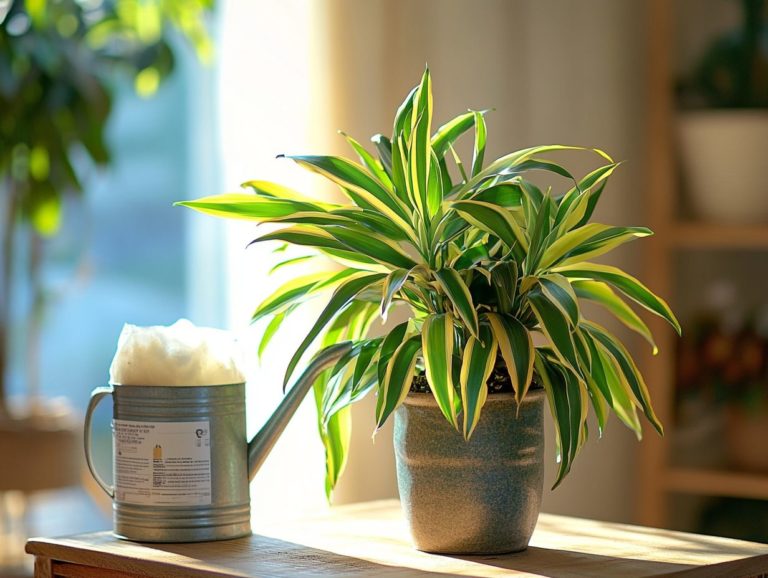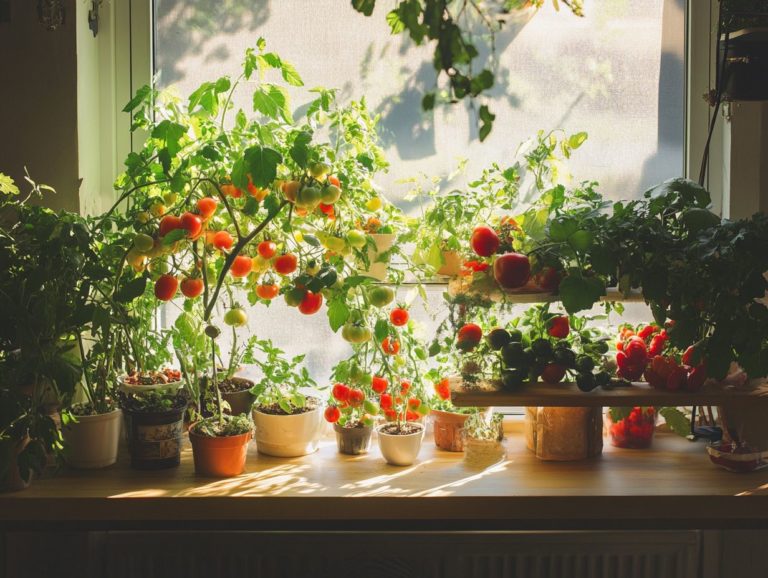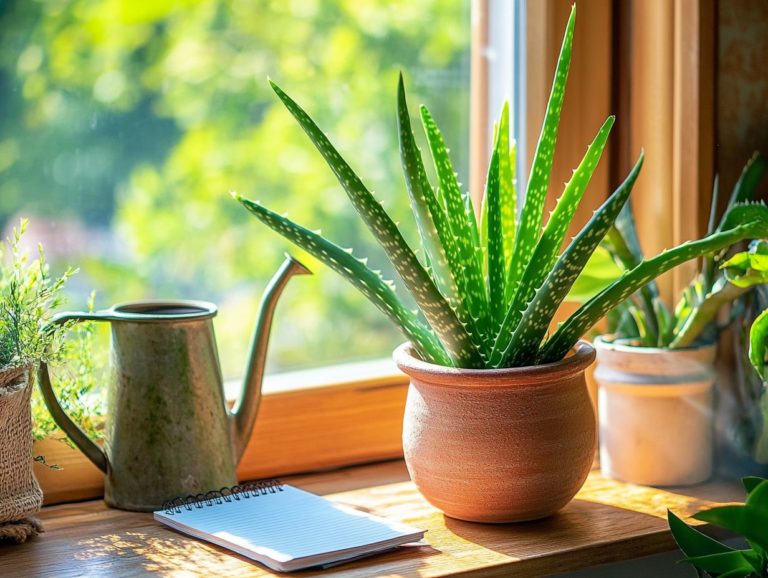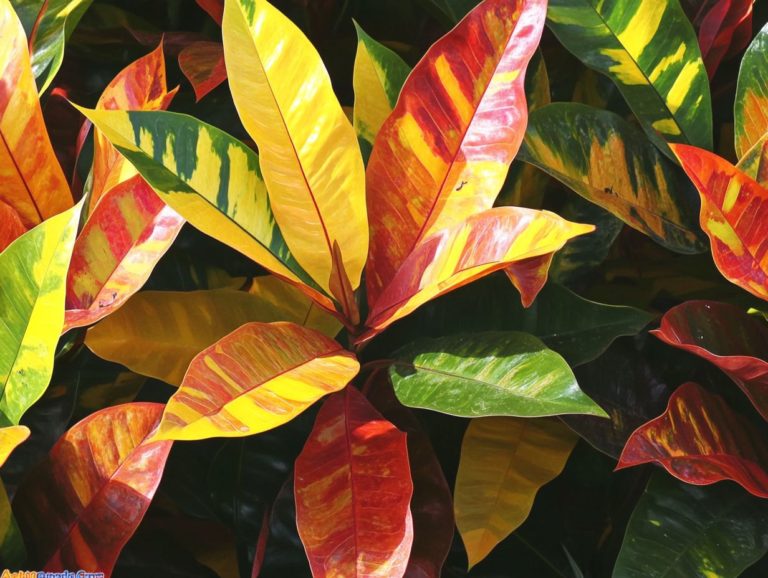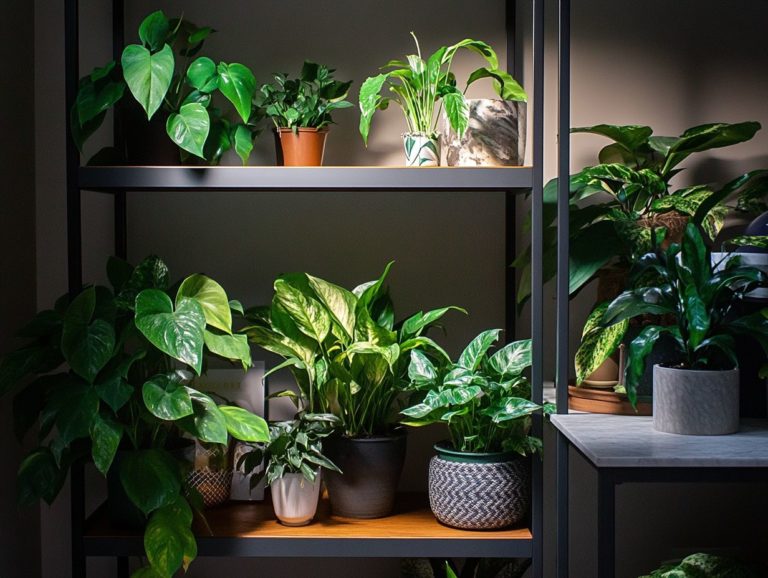Top 10 Air-Purifying Indoor Plants
Are you eager to create a breath of fresh air in your home? Explore the top 10 air-purifying indoor plants that not only elevate your space s aesthetic but also significantly improve your indoor air quality.
From the hardy Snake Plant to the calming Peace Lily, these plants provide a multitude of benefits that extend far beyond mere beauty.
Delve into how these plants function, what it takes to care for them, and any potential risks involved. Join in as you discover why these vibrant additions might be exactly what your indoor plants have been longing for!
Contents
- Key Takeaways:
- 1. Snake Plant
- 2. Aloe Vera
- 3. Spider Plant
- 4. Peace Lily
- 5. English Ivy
- 6. Bamboo Palm
- 7. Rubber Plant
- 8. Dracaena
- 9. Philodendron
- 10. Boston Fern
- What Makes These Plants Effective Air Purifiers?
- How Do These Plants Improve Indoor Air Quality?
- What Are the Other Benefits of Having These Plants in Your Home?
- How Many Plants Are Needed to Purify the Air in a Room?
- What Are the Care and Maintenance Requirements for These Plants?
- Are There Any Potential Risks or Side Effects of Having These Plants in Your Home?
- Can These Plants Be Used in Offices or Commercial Spaces?
- What Are Some Other Air-Purifying Plants to Consider?
- How Do These Plants Compare to Air Purifiers?
- Why You Should Invest in These Amazing Plants!
- Frequently Asked Questions
Key Takeaways:
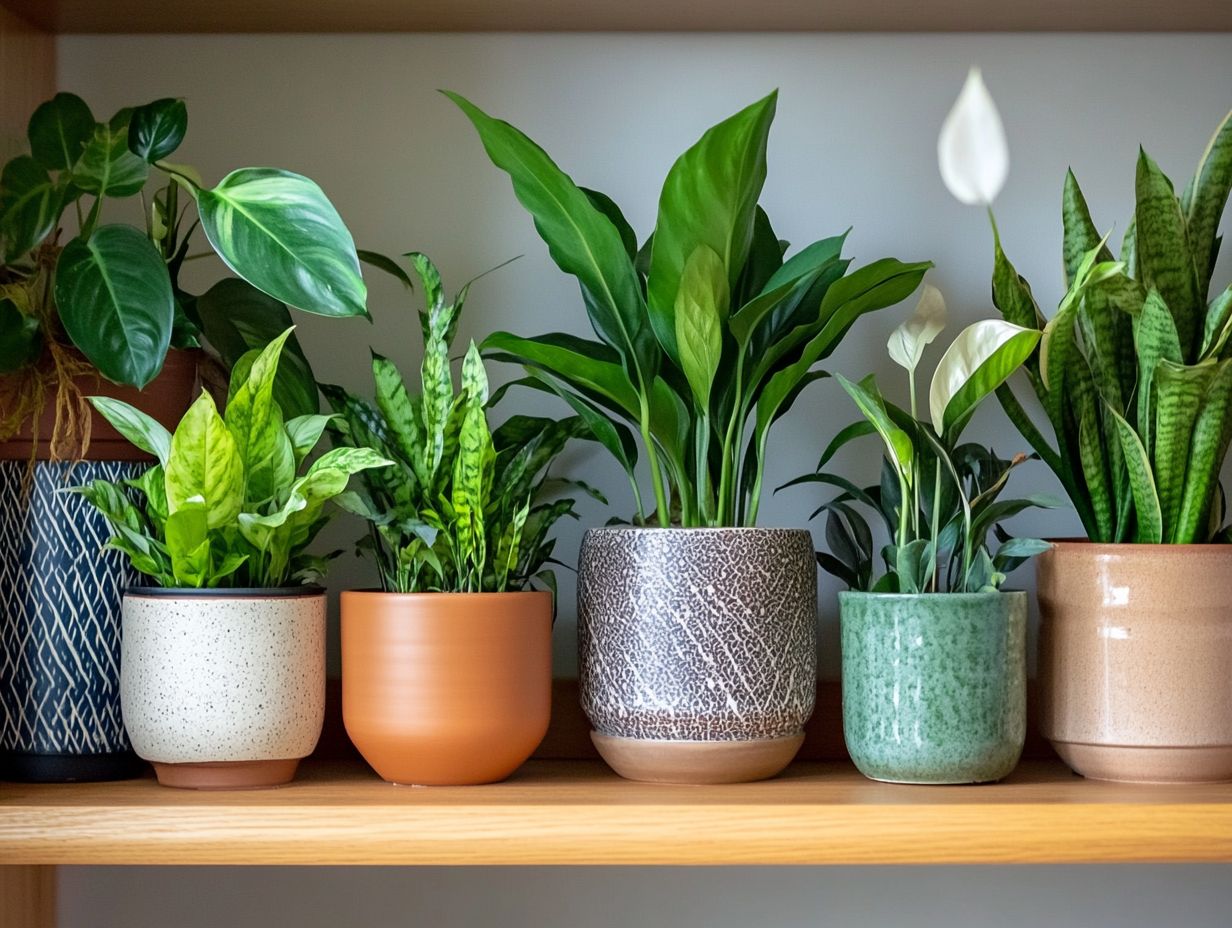
- Incorporating air-purifying plants like the Snake Plant and Peace Lily into your home can improve indoor air quality.
- These plants not only purify the air but also offer benefits such as reducing stress, increasing productivity, and adding aesthetic value to your space.
- To effectively purify the air in a room, it is recommended to have at least one air-purifying plant for every 100 square feet of space, such as the Boston Fern and Weeping Fig.
1. Snake Plant
The Snake Plant, or Sansevieria, stands out as an exceptional indoor plant, renowned for its air-purifying prowess. It s an ideal choice for elevating air quality in your home or office while helping the environment by filtering harmful chemicals like volatile organic compounds (VOCs), formaldehyde, and benzene.
Its unique ability to convert carbon dioxide into oxygen at night is impressive. This makes it a perfect companion for your bedroom, fostering a restful sleep environment.
The Snake Plant thrives with minimal care, requiring only occasional watering and adapting to a range of light conditions. This makes it a fantastic option for both novice gardeners and those with busy lifestyles.
As it diligently works to eliminate pollutants and enhance indoor air quality, this resilient plant beautifies your spaces and cultivates a healthier atmosphere, effortlessly fitting into various home and office settings.
2. Aloe Vera
Another fantastic option is Aloe Vera. It is not just known for its soothing gel; it also stands out as an exceptional air-purifying indoor plant that effectively removes toxins and enhances the air quality in your living spaces.
This remarkable plant filters out common indoor air pollutants, such as formaldehyde and benzene, which often linger in homes due to furniture and cleaning products. As it absorbs these harmful substances, it releases fresh oxygen, contributing to a healthier atmosphere for you and your family.
Beyond its air-cleaning prowess, Aloe Vera boasts numerous health benefits, including promoting hydration and aiding skin healing. This makes it a versatile addition to any home.
By incorporating this resilient, easy-to-care-for plant into your interior decor, you not only improve indoor air quality but also elevate your overall well-being.
3. Spider Plant
The Spider Plant, with its stunning cascading leaves and effortless care, stands out as a true champion of air purification. It s no wonder this plant has become a beloved choice for enhancing indoor air quality.
This remarkable plant filters out harmful pollutants like formaldehyde and xylene that often linger in indoor environments. Its resilience means it flourishes under various lighting conditions, whether basking in bright, indirect sunlight or thriving in partial shade, making it adaptable to your unique spaces.
The benefits continue. The Spider Plant also helps regulate humidity levels, creating a more comfortable atmosphere.
By welcoming this green wonder into your home, you not only elevate the aesthetic but also cultivate a healthier living environment, ultimately improving overall well-being for everyone.
Don t miss out on how these plants can enhance your well-being! Start your green journey today!
4. Peace Lily
The Peace Lily is celebrated not just for its elegant beauty but also for its remarkable air-purifying abilities. This plant effectively filters pollutants from your indoor air, contributing to environmental protection while enhancing the overall air quality in your home.
It also effectively removes harmful chemicals like formaldehyde, benzene, and carbon monoxide, making it an ideal companion for indoor spaces. Caring for a Peace Lily is easy; it thrives in low light and only requires watering when the soil feels dry.
Aesthetically, its lush green leaves and striking white flowers create a stunning visual impact, making it a must-have for any room that needs a touch of life! The Peace Lily not only elevates your space but also fosters a healthier atmosphere, appealing to both seasoned plant enthusiasts and those new to plant care.
5. English Ivy
English Ivy is a truly versatile indoor plant, renowned for its exceptional ability to purify the air by removing harmful chemicals. It s an essential component of any clean air initiative you may undertake.
With its cascading vines and vibrant green leaves, English Ivy not only enhances the aesthetic appeal of your space but also thrives effortlessly in manageable conditions. It flourishes in moderate, indirect sunlight and prefers moist, well-drained soil, requiring only minimal upkeep.
Beyond its impressive toxin-absorbing prowess, English Ivy plays a vital role in enhancing indoor humidity levels, effectively combating dryness that can lead to respiratory issues. It helps reduce airborne mold and bacteria, fostering a healthier environment for everyone who occupies the space.
6. Bamboo Palm
The Bamboo Palm is a striking air-purifying indoor plant that not only elevates the beauty of your space but also plays a vital role in improving air quality by filtering out harmful pollutants and boosting oxygen levels.
This vibrant plant thrives in indirect sunlight, making it a perfect addition to both homes and offices. It effortlessly harmonizes with various interior design styles, from modern minimalist to bohemian chic.
With its lush, feathery fronds, the Bamboo Palm requires minimal care, flourishing with just regular watering and occasional misting to maintain humidity. As a versatile choice, it serves not only as an eye-catching decorative element but also as a savvy investment in fostering a healthier indoor environment, ultimately contributing to your overall well-being.
7. Rubber Plant
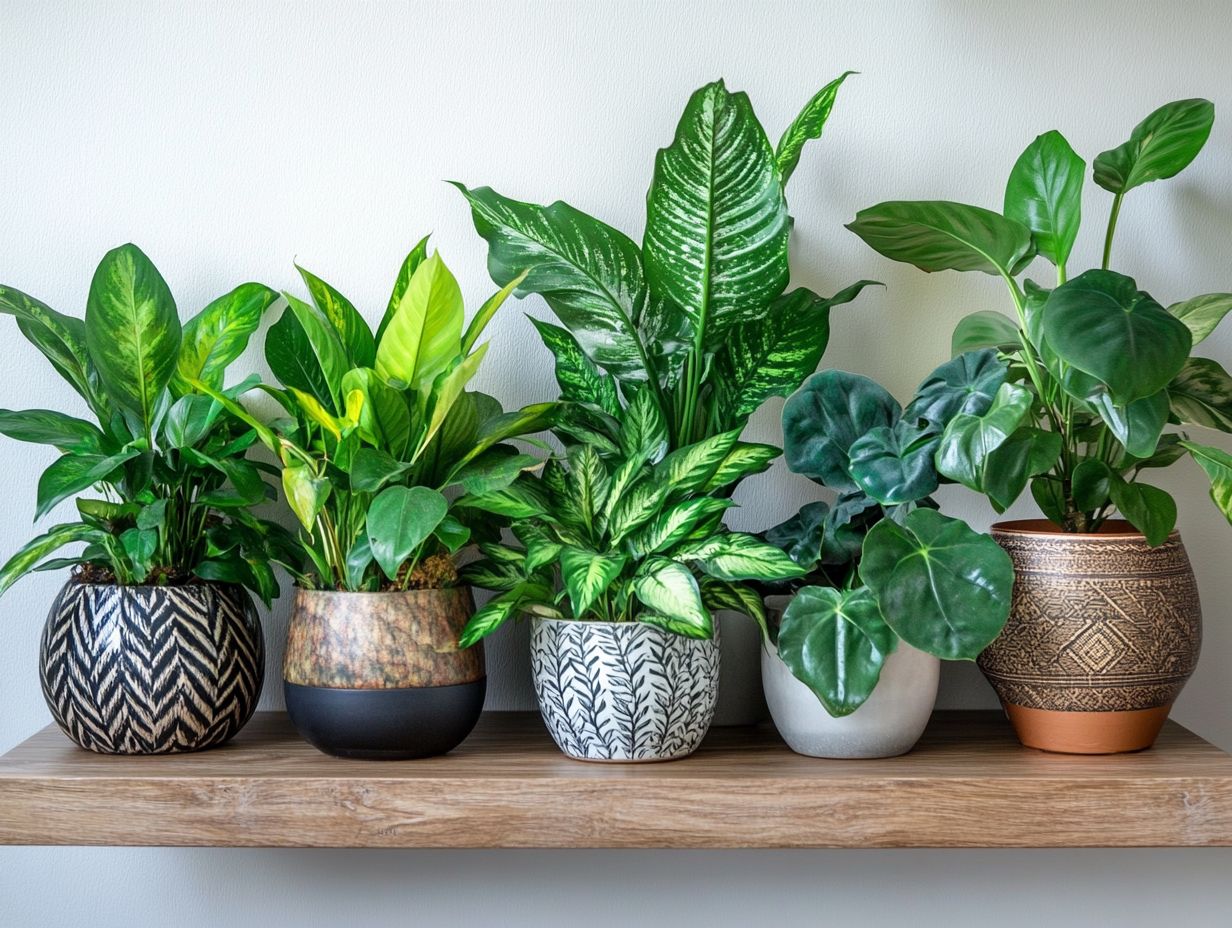
The Rubber Plant is a robust air-purifying indoor companion, renowned for its knack for removing toxins from the air while enhancing your home decor with a splash of greenery.
This striking plant not only enhances the visual charm of your space but also diligently filters out harmful substances like formaldehyde and benzene, making it an invaluable asset in any indoor setting.
To ensure its thriving growth, provide moderate, indirect sunlight and let the soil dry out between waterings. A gentle wipe of the leaves will keep them dust-free, maximizing their air-purifying prowess.
With its remarkable ability to enhance indoor air quality and minimal maintenance requirements, the Rubber Plant is an exceptional choice for both novice and seasoned plant enthusiasts alike, making it a staple among houseplants.
8. Dracaena
Dracaena is a favored choice among indoor plants, acclaimed for its captivating appearance and impressive air-purifying abilities, particularly in eliminating harmful chemicals and improving air quality within your indoor spaces.
With a variety of species available such as Dracaena marginata, Dracaena fragrans, and Dracaena sanderiana these plants not only elevate the aesthetic charm of your environment but also significantly contribute to a healthier living atmosphere.
To achieve optimal growth, it s crucial to position them in well-draining soil, shield them from direct sunlight, and maintain moderate humidity levels. These elements are vital for maximizing their air-cleansing potential, especially for effective photosynthesis, the process plants use to turn sunlight into energy.
9. Philodendron
Philodendron is a cherished indoor plant. It enhances your space and helps improve indoor air quality by filtering out toxins.
This plant thrives in low to bright indirect light. Its resilience to humidity fluctuations makes it suitable for any room.
To help it reach its full potential, water it regularly. A little feeding during the growing season keeps it lush and vibrant.
10. Boston Fern
The Boston Fern is an air-purifying indoor plant. It effectively removes indoor air pollutants, making it a great choice for clean air.
This plant thrives in humid environments and prefers indirect sunlight. Its delicate fronds not only look elegant but also filter toxins like formaldehyde and xylene.
Care for your Boston Fern by keeping the soil moist. Regular misting boosts humidity, especially during dry seasons.
What Makes These Plants Effective Air Purifiers?
These plants are effective air purifiers because they absorb volatile organic compounds and toxins through their leaves and roots. Research from the Environmental Protection Agency and the NASA Clean Air Study highlights their role in creating clean indoor air.
These studies show how plants thrive in spaces filled with pollutants. They convert carbon dioxide into oxygen through photosynthesis, using sunlight and chlorophyll.
Some indoor plants can remove up to 87% of air toxins within just 24 hours. This ability emphasizes their contribution to your health and well-being.
How Do These Plants Improve Indoor Air Quality?
Air-purifying plants filter out harmful chemicals and toxins. This ultimately enhances air quality and creates a healthier living space.
They absorb pollutants like formaldehyde, benzene, and trichloroethylene. For example, the spider plant excels at removing formaldehyde, while the peace lily targets benzene and ammonia.
These plants not only reduce air toxicity but also improve respiratory function and lower stress levels. Adding greenery to your home promotes relaxation and productivity, supporting holistic health.
What Are the Other Benefits of Having These Plants in Your Home?
Beyond their impressive air-purifying abilities, incorporating indoor plants into your home offers a wealth of benefits. They enhance aesthetic appeal, uplift mental health, and foster a deep connection to nature, all while contributing to environmental protection.
Integrating greenery into your living space significantly boosts your mood, cultivates a vibrant atmosphere, and ignites your creativity. Research shows that being surrounded by nature, even in the form of potted plants, can effectively alleviate anxiety, sharpen concentration, and promote a sense of tranquility.
Indoor plants are stunning decor that can transform any room, whether modern or rustic. These living decorations not only breathe life into a room but also play a crucial role in nurturing sustainability by reducing carbon footprints and promoting biodiversity.
Embracing indoor plants can truly transform not just your living spaces but also your overall well-being and ecological awareness. Start integrating indoor plants today for a healthier home!
How Many Plants Are Needed to Purify the Air in a Room?
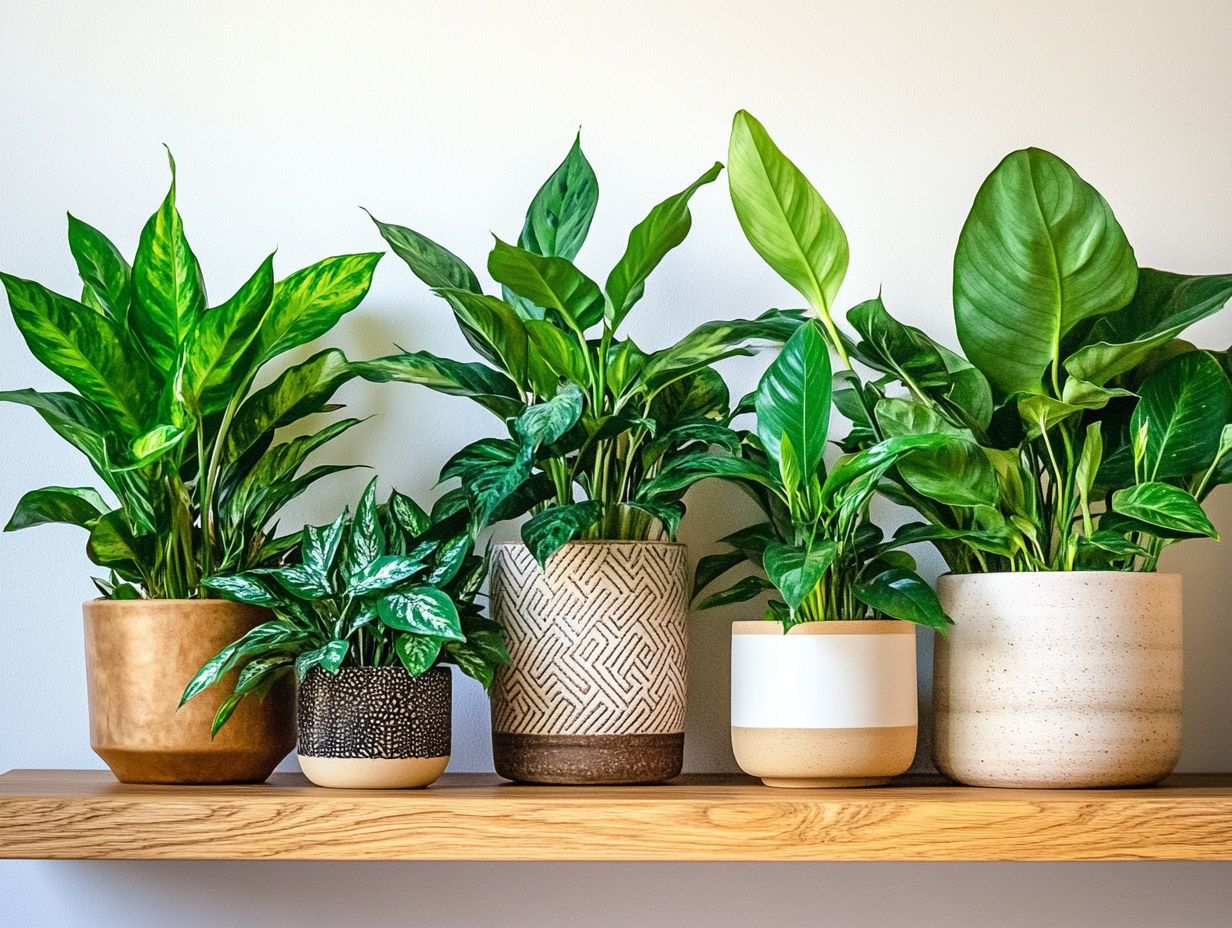
The number of air-purifying plants needed to cleanse the air in a room depends on several factors, including the size of the space, the types of plants, and the existing indoor air quality. Generally, a few well-placed plants can make a remarkable difference in enhancing clean air.
For optimal results, experts recommend positioning one to three plants per square foot, tailored to the size and growth requirements of the species you choose. Consider the lighting conditions and humidity levels when deciding where to place your plants; some species flourish in bright spots, while others thrive in lower light settings.
Mixing various types of plants can elevate the air purification process, as certain species are particularly effective at targeting specific pollutants. This thoughtful combination not only maximizes your air quality improvement but also transforms your indoor space into a vibrant, visually appealing environment, providing you with both aesthetic pleasure and health benefits.
What Are the Care and Maintenance Requirements for These Plants?
Caring for air-purifying indoor plants requires you to understand their unique maintenance needs, including light, water, and soil conditions. This ensures they thrive and continue to enhance the air quality in your home.
To achieve optimal growth, provide just the right amount of indirect sunlight, as too much direct light can scorch the leaves of these delicate plants. Regular watering is key; allow the top inch of the soil to dry out between sessions to keep the roots healthy without drowning them. Choosing well-draining potting mixes can improve soil aeration and prevent root rot, which is vital for their longevity.
By familiarizing yourself with these specific requirements, you can effortlessly cultivate a vibrant indoor oasis that beautifies your space while also contributing to a healthier environment.
Are There Any Potential Risks or Side Effects of Having These Plants in Your Home?
While indoor plants offer a plethora of benefits, be aware of potential risks or side effects, such as allergies or toxicity in certain species. This is important for maintaining a safe and healthy living environment.
Take the Peace Lily, for example. It’s a popular choice thanks to its lush foliage and air-purifying abilities, but it poses a significant risk to pets. It contains calcium oxalate crystals, which can irritate mouths if ingested and lead to digestive issues.
To mitigate these risks while beautifying your indoor space, consider opting for non-toxic alternatives like:
- Spider plants
- Boston ferns
These plants thrive in typical indoor conditions and pose little to no risk to curious pets. To enhance their growth, consider using top 10 grow lights for indoor plants. This way, you can create a vibrant, lively atmosphere in your home, allowing everyone—both humans and pets—to enjoy the environment without worry.
Can These Plants Be Used in Offices or Commercial Spaces?
These air-purifying indoor plants are perfect for your home and can elevate offices and commercial spaces, enhancing air quality and employee well-being.
Incorporating greenery into your office instantly enhances aesthetic appeal, creating a warm and inviting atmosphere for both employees and clients. The presence of plants reduces stress levels, fostering a more positive work environment.
Research shows that having flora around significantly boosts productivity, with employees experiencing heightened creativity and focus. Beyond these perks, plants filter indoor air toxins, ensuring a healthier workplace that alleviates fatigue and promotes overall wellness.
This holistic approach benefits individual team members and paves the way for greater organizational success.
What Are Some Other Air-Purifying Plants to Consider?
Along with well-known air-purifying champions like the Snake Plant and Peace Lily, you have many options to elevate the air quality in your indoor spaces.
Take the Spider Plant, for example it’s a stellar choice, adept at removing formaldehyde and xylene while thriving on moderate light and occasional watering.
Then there s the Boston Fern, renowned for its natural air-filtering prowess. It flourishes in high humidity and indirect light, with a little regular misting to keep it happy.
Don t overlook the Areca Palm, which excels at humidifying the air and filtering toxins. It s relatively low-maintenance and adapts well to various lighting conditions.
You might also consider the Rubber Plant, celebrated for its robust nature and impressive ability to absorb toxins. It thrives best in bright, indirect light with consistent watering.
Incorporating these plants not only boosts air quality but also transforms your living space into a more vibrant and inviting haven.
How Do These Plants Compare to Air Purifiers?
While air purifiers efficiently filter pollutants from your environment, consider the charm of air-purifying indoor plants as a beautiful option that elevates air quality while beautifying your living spaces.
These botanical gems do more than just look good; they diligently absorb toxins and release oxygen, making your home feel fresher and more inviting. The effectiveness of these plants varies widely based on their type and the conditions they need.
On the other hand, air purifiers are devices that clean the air using filters and deliver consistent performance, regardless of room size. This reliability makes them a solid choice for larger or enclosed spaces.
While air purifiers may have higher upfront costs and ongoing maintenance needs, such as filter replacements, their ability to swiftly eliminate airborne contaminants often outpaces that of plants.
Ultimately, consider your personal needs and the specifics of your environment when deciding between these two air quality solutions whether you choose mechanical air purifiers or houseplants.
Why You Should Invest in These Amazing Plants!
Investing in air-purifying indoor plants elevates not just the aesthetics of your spaces but also plays a pivotal role in improving air quality and enhancing your overall well-being.
These remarkable green companions are more than just decor; they actively filter harmful toxins and pollutants from the air, cultivating a healthier environment for you and your loved ones.
They tackle unwanted substances like formaldehyde and benzene while generously releasing oxygen, ensuring better breathability in your home or office.
By welcoming these plants into your spaces, you can experience a noticeable boost in both mood and productivity, making them an ideal addition for areas dedicated to relaxation and work alike.
Ultimately, incorporating air-purifying plants into your daily life harmonizes the beauty of nature with the essential pursuit of healthier living.
Frequently Asked Questions

What are the top 10 air-purifying indoor plants?
The top 10 air-purifying indoor plants include Spider Plant, Peace Lily, Snake Plant, Bamboo Palm, Aloe Vera, English Ivy, Rubber Plant, Dracaena, Chinese Evergreen, and Golden Pothos.
Explore these options today and transform your space!
Why are these plants the best for indoor air purification?
These plants are proven to remove harmful pollutants like formaldehyde, benzene, and carbon dioxide. They help improve indoor air quality.
How do these plants purify the air?
Plants absorb pollutants through their leaves and roots. They convert these into oxygen during photosynthesis, enhancing indoor air quality.
Can these plants improve overall indoor air quality?
Absolutely! These plants reduce harmful toxins and volatile organic compounds (VOCs) in the air. This makes your indoor environment safer and healthier.
Do these plants require a lot of maintenance?
No, most of these plants are low maintenance. They thrive in various indoor settings with just regular watering and indirect sunlight.
Can these plants also add beauty to indoor spaces?
Yes! These plants come in various shapes, sizes, and colors. They enhance the aesthetics of any indoor space and create a calming atmosphere.

